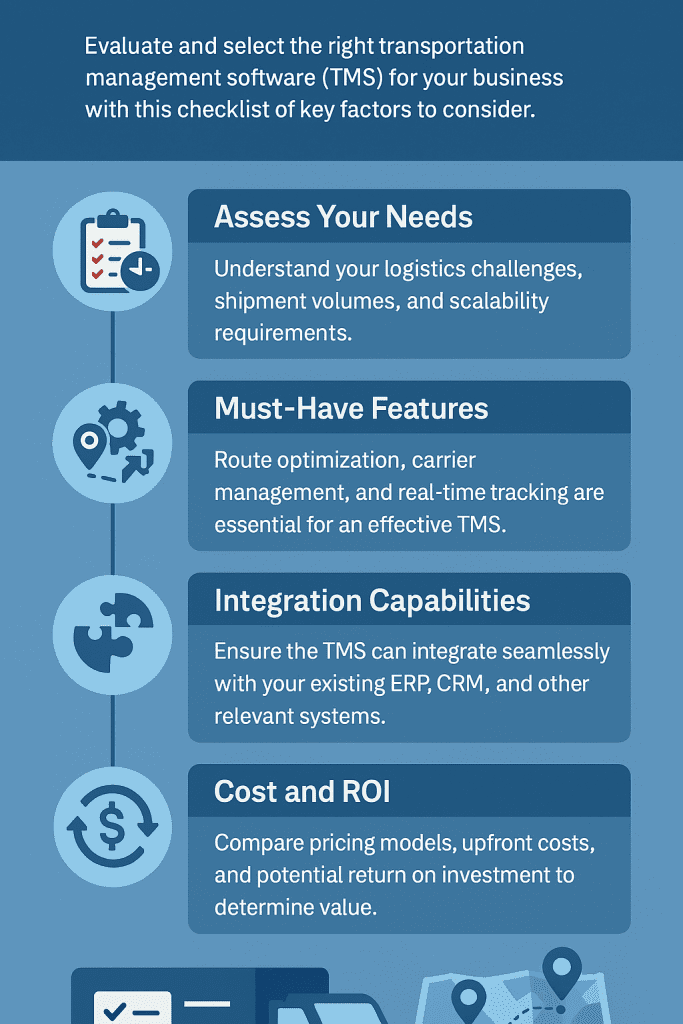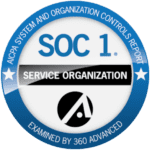📌 Quick Summary: How to Choose the Best Transportation Management Software
Choosing the right transportation management software (TMS) for your business involves evaluating your logistics needs, comparing must-have features like route optimization and carrier management, and ensuring the platform integrates with existing systems like ERP or CRM. This checklist simplifies the decision-making process so your supply chain stays efficient and scalable.
In today’s fast-paced world, using only the best transportation management software is essential for the success of any business. From supply chain logistics to fleet management, modern businesses rely heavily on transportation systems to keep their operations running smoothly.
As technology continues to evolve, the role of software in managing transportation has become increasingly important. However, with so many options available in the market, choosing the right transportation management system software can be a daunting task. Fear not!
This comprehensive checklist will guide you through all the key considerations when selecting transportation management software for your business.

1. Identify Your Business Needs
Before diving into the sea of available transportation management solutions, it’s crucial to first identify the specific needs of your business.
a. List Out Specific Transportation Challenges Your Business Faces
Every business is unique, and so are its challenges. From managing fleet maintenance to tracking transportation costs, list out the specific issues your business is currently facing in its transportation processes.
It will help you understand what you need in a software solution and ensure that the solution you choose is tailored to address these particular challenges.
b. Determine Must-Have Features for Effective Management
Once you’ve identified your challenges, the next step is to determine the essential features that your transportation management software must include for effective management. These could range from real-time tracking and automated scheduling to route optimization and cost analytics.
Be sure to differentiate between ‘nice-to-have’ and ‘must-have’ features, as this will guide you in prioritizing which functions are truly necessary for your operations.
2. Research Different Software Options
Once you’ve nailed down your business needs and the essential features of your transportation management software, it’s time to start researching available options.
a. Look at Industry Leaders and Their Offerings
Begin your research by exploring the leading players in the transportation management software market. These vendors are often at the forefront of technology and offer a wide range of features.
Investigate their software specifications, capabilities, and unique selling propositions. It will give you a benchmark for what is currently available in the industry and potentially align with your requirements.
b. Consider Reviews and Ratings from Other Businesses
To gain a better understanding of how the software performs in real-world scenarios, peruse reviews and ratings from other businesses that have used the software. These reviews can offer invaluable insights into the software’s reliability, ease of use, customer service, and overall performance. Websites like Capterra and G2 Crowd can be good platforms to start your review search.
c. Compare Prices and Packages Offered
Finally, after narrowing down your options, compare the pricing and packages of your preferred software options. While it’s important to remain within your budget, don’t just go for the cheapest option. Instead, consider the value each package offers in terms of features, scalability, and long-term ROI. Remember, a more expensive option might offer advanced features that save your company money in the long run.
3. Assess Integration Capabilities
Once you have shortlisted potential transportation management software options based on your business needs, essential features, and budget, the next crucial step is to assess their integration capabilities.
a. Make Sure the Software Can Integrate with Existing Systems
One of the most significant aspects to consider is whether the software can seamlessly integrate with your existing systems, such as your order management and warehouse management systems. It is crucial as it ensures smooth data flow, reduces manual labor, and avoids data duplication. Discuss with potential vendors about their software’s compatibility with your current systems.
b. Check for Compatibility with Future Technology Upgrades
In a world where technology is continuously evolving, the software you choose must be ready to adapt to future technology upgrades. Check to see if the software is built on a scalable architecture and if regular software updates are part of the package.
It will ensure the software can adapt to your business’s growth and changes in the industry, providing a longer-term solution for your transportation management needs.
4. Consider User-Friendliness
Choosing a user-friendly transportation management software can significantly reduce the learning curve for your team and ensure a smooth transition.
a. Look for an Intuitive Interface That Is Easy to Navigate
The software interface should be intuitive and easy to navigate, even for those with little to no technical skills. Look for software that has clear navigation menus, straightforward features, and a well-organized layout. The ease of use can significantly reduce the time taken to get accustomed to the software, thus improving productivity.
b. See If the Software Offers Training or Support Services
It’s also important to consider the support provided by the software vendor. Check if the vendor offers comprehensive training programs to help your team get up to speed with the software. Additionally, a reliable customer support service that responds quickly to queries and issues can be a valuable resource in ensuring the smooth operation of your transportation management processes.
5. Evaluate Security Measures
When dealing with sensitive data like transportation routes, customer details, and financial information, you must ensure that your chosen transportation management software has robust security measures in place.
a. Ensure the Software Has Strong Data Encryption and Protection Measures
To safeguard your critical data, ensure the software uses strong encryption methods during both transmission and storage of data. Ask potential vendors about their data protection protocols and their compliance with international standards like ISO 27001 or regulations like GDPR. Also, inquire about their user access management capabilities to prevent unauthorized access from within the organization.
b. Check If They Have Backups and Disaster Recovery Plans in Place
In the event of data loss due to accidental deletion, system malfunctions, or even cyber-attacks, having a backup and disaster recovery plan is crucial. Confirm that the software provider regularly backs up data and inquire about their disaster recovery strategies.
Ensuring they have a robust plan can give you peace of mind knowing that your transportation management operations can recover quickly in the face of adversity.
6. Calculate Return On Investment (ROI)
When investing in transportation management software, it’s important to consider the potential return on investment (ROI). The upfront cost of implementing new software can seem daunting, but it’s crucial to look beyond this initial investment and consider the longer-term financial benefits.
a. How Investing in Transportation Management Software Can Save Time and Money in the Long Run
Investing in quality transportation management software can lead to significant time and cost savings in the long run.
Firstly, automation of repetitive, manual tasks helps reduce labor costs and free up your staff for more strategic, high-value tasks.
Secondly, features like route optimization can result in substantial fuel savings and increase the efficiency of your transportation operations. Advanced analytics provided by these systems can also help identify inefficiencies and bottlenecks in your processes, supporting better decision-making and ultimately boosting profitability.
Furthermore, by integrating your existing systems like order and warehouse management with the TMS, you can avoid data duplication and errors, saving time and the associated costs.
Lastly, the improved customer service resulting from accurate tracking and timely deliveries can lead to increased customer retention and, consequently, higher revenue.
Therefore, while there is an initial cost associated with implementing transportation management software, the long-term benefits and cost savings make it a worthy investment. According to a study by ResearchGate, companies implementing transportation management software can see a 10-20% reduction in transportation costs and a 15-30% increase in efficiency.
7. Consult with Team Members
Involving your team in the software selection process is a crucial step that should not be overlooked. After all, they will be the ones using the software daily and their input can provide valuable insights that can help you make a more informed decision.
a. Get Input from Relevant Team Members Who Will Use the Software
Seek the opinions of those in your team who will be directly using the software. It could include your fleet managers, logistics coordinators, supply chain analysts, and other relevant personnel.
They might have specific requirements or features that they would like the software to have, which can assist in refining your list of software options. Additionally, their hands-on experience can shed light on practical aspects that might not be apparent from a higher-level perspective.
b. Discuss Their Concerns and Expectations
It’s also important to understand any concerns your team might have about implementing new software, such as the learning curve, transition process, and potential disruptions to daily operations.
Also, discuss their expectations for the new software and the improvements they hope to see in their day-to-day tasks. Addressing these concerns and managing expectations from the onset will facilitate a smoother transition and increase the acceptance of the new software among your team.
10. Making the Final Decision
After meticulously carrying out the above steps, you’ll be well-equipped to make an informed decision about which transportation management software best aligns with your business needs and objectives.
a. Review Your Findings and Shortlisted Options
Revisit all the information gathered during your research, needs identification, and consultation processes. Review the shortlisted software options, their features, costs, security measures, user reviews, and integration capabilities.
b. Weigh Pros and Cons
For each software option, weigh the pros and cons. Consider the alignment of each solution with your identified business needs, must-have features, and budget. Also, assess the potential impact of each option on your team’s workflow and overall business operations.
c. Make the Final Selection
Now, it’s time to make the ultimate decision. Based on the comprehensive analysis and assessment, choose the software that best fits the needs of your business, promises a good return on investment, and is likely to be accepted and successfully implemented by your team.
Remember, the goal is to choose software that addresses your current transportation challenges and can adapt and grow with your business in the future. A strategic decision now can pave the way for smoother
Dive Deeper Into Transportation Management
If you’re exploring transportation management in more depth, check out these related guides and insights:
📦 Freight Routing Guide – Learn how proper freight routing saves time and money.
🧭 How TMS Software is Used for Brokerages – Discover how brokerages streamline operations with TMS.
💸 Manual Routing Guide Costs – See the hidden expenses of doing things the old-school way.
🧠 Mastering Logistics: Choosing the Best TMS – A deep dive into evaluating TMS platforms.
🔗 Navigating Your Supply Chain with the Right TMS – How the right system improves every link in your supply chain.
🧰 Transportation Management Software Guide – Your breakdown of key features and must-haves.
❓ What Is a Transportation Management System? – Start here if you’re new to the TMS world.
✅ FAQ: Choosing the Best Transportation Management Software
What is a transportation management system (TMS)?
A TMS is software that helps businesses plan, execute, and optimize the physical movement of goods. It improves routing, reduces freight costs, and provides real-time visibility into shipments.
Why is TMS software important for logistics?
It centralizes logistics operations, boosts delivery speed, reduces errors, and lowers overall shipping costs. For growing businesses, it becomes essential for scalability.
What should I look for in a TMS?
Key features include route optimization, carrier management, freight auditing, API integrations, and real-time shipment tracking.
Is cloud-based TMS better than on-premise?
Cloud-based TMS is often preferred for its lower upfront cost, faster deployment, and easier updates. It’s scalable and requires less IT maintenance than on-premise solutions.
Can a TMS integrate with ERP or CRM platforms?
Yes, many modern TMS platforms offer native or API-based integrations with ERP, WMS, and CRM tools to ensure seamless data flow across systems.



